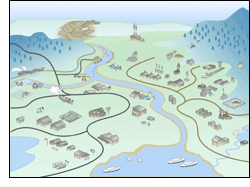Solid & Hazardous Waste Regulations:
 The Resource Conservation and Recovery Act (RCRA) regulates the management of solid waste (e.g., garbage), hazardous waste, and underground
storage tanks holding petroleum products or certain chemicals.
The Resource Conservation and Recovery Act (RCRA) regulates the management of solid waste (e.g., garbage), hazardous waste, and underground
storage tanks holding petroleum products or certain chemicals.RCRA was enacted in 1976 to address the huge volumes of municipal and industrial solid waste generated nationwide. The goals of RCRA as stated in the RCRA Orientation Manual [pdf], are as follows:
- To protect human health and the environment from the potential hazards of waste disposal
- To conserve energy and natural resources
- To reduce the amount of waste generated
- To ensure that wastes are managed in an environmentally sound manner
- Prevent future problems caused by irresponsible waste management
- Clean up releases of hazardous waste in a timely, flexible, and protective manner.
The Act consists of 10 subtitles. The two major programs that compromise RCRA are:
Subtitle C - Hazardous Waste Management
Subtitle D - State and Regional Solid Waste Plans
The other subtitles are as follows:
Subtitle A - General Provisions
Subtitle B - Office of Solid Waste; Authorities of the Administrator and Interagency Coordinating Committee
Subtitle E - Duties of the Secretary of Commerce in Resource and Recovery
Subtitle F - Federal Responsibilities
Subtitle G - Miscellaneous Provisions
Subtitle H - Research, Development, Demonstration, and Information
Subtitle I - Regulation of Underground Storage Tanks
Subtitle J - Standards for the Tracking and Management of Medical Waste
RCRA Subtitle C – Hazardous Waste - is a "cradle-to-grave" program set to ensure the proper management and disposal of hazardous wastes. RCRA specifically targets hazardous wastes that are currently in use or to be disposed of. RCRA applies to hazardous waste generators, transporters, and treatment, disposal, storage, and disposal facilities (TSDFs). All generators, transporters, and TSDF's are required to report discharges of the hazardous waste(s) to EPA on a monthly basis.
Tribes are responsible for implementing and enforcing the minimal requirements outlined in 40 CFR (parts 257 and 258). EPA's role for developing tribal plans is limited to:
- Establishing guidelines for the development and implementation of tribal plans
- Providing technical assistance
RCRA Subtitle D – Solid Waste - focuses on state and local governments as the primary planning, regulating, and implementing entities for the management of nonhazardous industrial solid waste.
Review the complete RCRA Orientation Manual [pdf] for more detailed information on RCRA.
Contaminants of Concern:
It should be noted that the Code of Federal Regulations should be investigated for any exceptions and exemptions and for specific waste names. A solid waste is defined in 40 CFR §261.2 as:A solid waste is any discarded material that is not excluded under §261.4(a) or by a variance or non- waste determination
This definition includes gases, liquids, sludge, solid, refuse, or any other discarded materials. Solid waste is then further defined as hazardous waste using two different mechanisms:
By listing certain specific solid wastes as hazardous (i.e., wastes from certain industrial processes or sources). Listed wastes include (40 C.F.R. §§ 261.31-261.33):
- Non-specified/solvents (F-list)
- Originating from specific processes (K-list)
- Acute hazardous wastes/commercial chemical products (P-list)
- Toxic wastes/commercial chemical products (U-list)
By identifying characteristics (i.e., physical or chemical properties) which, when exhibited by a solid waste, make it hazardous. Characteristic wastes include (40 C.F.R. §§ 261.21-261.24):
- Ignitable (D001)
- Corrosive (D002)
- Reactive (D003)
- Toxic (D004)
Making this determination is a complex task that is a central component of the hazardous waste management regulations. The Code of Federal Regulations under Title 40 should be investigated for any exceptions and exemptions and for specific information.
Implementing Solutions:
Please submit your experiences (successes/challenges) and tribal-specific documents to share on our website using the attached form.Download Form
Resources:
RCRA Orientation Manual [pdf]RCRA Presentation [pdf]
RCRA Online Reference Guide [pdf]
Websites:
RCRA Online is an electronic database of selected letters, memoranda, questions, answers, publications, and other outreach materials written by EPA's Office of Solid Waste.www.epa.gov/rcra (select RCRA Online under RCRA Tools and Resources)
Hazardous Waste Identification Process (EPA):
www.epa.gov/hw (select Identification under Hazardous Waste Program Areas)
RCRA Training Modules (EPA):
www.epa.gov/rcra/resource-conservation-and-recovery-act-rcra-training-modules
Solid Waste Management on Tribal Lands:
www.epa.gov/region9/waste/tribal/index.html
Code of Federal Regulations:
www.gpo.gov/fdsys/browse/collectionCfr.action?collectionCode=CFR
Related Pages:
Brownfields PageCoal Mining
Contaminated Sites Page
Federal Facilities Page
Hazardous Substance Reporting Requirements
RCRA vs. CERCLA
Superfund CERCLA
Underground Storage Tanks
Hazardous Materials Transport
For more information, please contact:
Jennifer Williams, Alaska Program Coordinator, Sr.
Tel: 928/523-0673
Email: Jennifer.Williams@nau.edu
Tel: 928/523-0673
Email: Jennifer.Williams@nau.edu
Last updated: November 21, 2016
